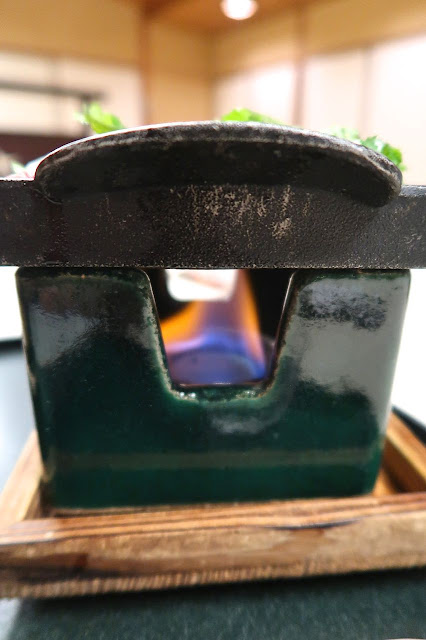Deep in the lush Kasugayama primeval forest behind the magnificent Kasuga-Taisha Shrine, Tsukihitei is the perfect setting for enjoying the finest Japanese Kaiseki cuisine. From the winding drive through Nara's verdant UNESCO protected forest to Tsukhitei's covered woodland pathway and the tranquillity of our private Japanese-style tatami dining room, Tsukihitei is a special world unto itself. Built in 1902 for the Governor of Nara by shrine carpenters of the time, the small luxury ryokan has since hosted members of the Imperial family and other dignitaries, drawn to the top quality kaiseki cuisine. The epitome of Japanese haute cuisine, kaiseki is the embodiment of omotenashi, the spirit of gracious hospitality that anticipates and fulfills every guest's needs.
Using the finest local ingredients to create the perfect seasonal theme for each gourmet multi-course kaiseki dinner, every dish at Tsukihitei is a work of art, beautifully arranged and garnished to seduce the eyes as well as the palate. From the sensational autumn-inspired menu of homemade tofu, exquisite grilled fish, gorgeous roasted locally sourced vegetables, and sublime Wagyu Sukiyaki to the steamed Shinmai rice with red beans and corn served in a traditional Japanese cedar meshibitsu and handcrafted Toyosawa sake - and with each dish graciously served by our bowing Komono-clad hostess - Tsukihitei is a rare culinary treasure tucked away in Nara's lush antediluvian woodland paradise.
Set within the Kasugayama Forest behind Kasuga-Taisha Shrine,
Tsukihitei is a luxury Ryokan and the perfect setting for the finest Kaiseki in Nara
Covered pathway up to Tsukihitei on the crest of a hill
The property was built in 1902 for the Governor of Nara
A private room for our Kaiseki dinner
Seasonal floral arrangement in the dining room nook
Japanese scroll detail of little chicks
Chopsticks with Tsukhitei logo in Japanese Kanji script
Lovely covered bowl with flowery lid
Chrysanthemum Tea
Chilled Junmai Sake from Toyosawa Brewery in Nara served in a silver Chirori sake pot
Vintage sake cup
Nara's Toyosawa Sake Brewery began in 1868
Tsukihitei Kaiseki dinner menu
First course of our Kaiseki dinner was beautifully presented under a bamboo cage
Black bean and edamame tofu with salmon roe served in a crystal bowl
Selection of sashimi
Abalone
Japanese Blue Tailed King Prawn
Medium and Fatty Tuna
Soup with egg custard shaped like a full moon, poached fish,
seaweed and micro greens snipped to look like pine needles
The spectacular autumn-themed 'Hassun' course of seasonal dishes
garnished with a fan-shaped gingko leaf - a symbol of peace
The most ancient fruit in Japan, this chestnut-inspired bite with short noodles created to resemble the prickly outer shell of a 'kuru' is filled with a cooked sweet chestnut
Japanese kuri (chestnut) are harvested in the autumn
The culinary artistry in one little morsel
Grilled Anago
Satoimo, a small simmered Japanese taro harvested in the autumn
Okara
Shokupan with Shiitake mushroom and riced egg yolk
Braised octopus with thick tsume sauce
Lovely blue and white ceramic futamono, or bowl with lid
Soup with Matsutake and Shiitake mushrooms on Oshiruko rice flour dumpling
Yakimono course with grilled Japanese Pacific Saury on roasted eggplant with shiso pepper and garnished with bright red Shilgochu, very thinly sliced dried chili peppers
Sukiyaki with Iga Beef, famous throughout the region for it's fatty, well-marbled beef
served with sliced daikon and chrysanthemum leaves
Sukiyaki cast iron pan (nabemono) over ceramic base with open flame that cooks the meat and vegetables
Sukiyaki is served with a raw egg into which the cooked meat is dipped before eating
Chilled prawn with gingko jelly, fuki (Japanese butterbur), grilled rice and Karachi,
a Japanese yellow mustard
Red lacquer miso soup bowl with gold bamboo leaf pattern
Miso soup
Served in a Japanese cedar meshibitsu, the rice is an essential course in a Kaiseki meal
Japanese steamed Shinmai rice with red beans and corn
Tsukemono or pickled vegetables are served as a stand-alone course in Kaiseki
Genmai tea
A traditional Japanese teapot with bamboo handle with delicious hot Genami tea
Mizumono or dessert of Japanese Honeydew melon, Asian pear and Konnyaku grape jelly















































No comments:
Post a Comment